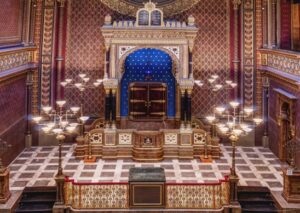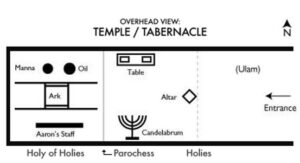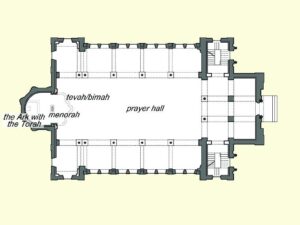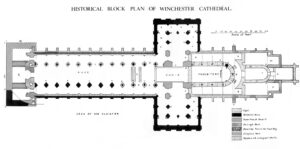
Most people do not know or do not associate that during the period of the temple there were already synagogues, not only for those in the diaspora, but for all Jews wherever they were, including Jerusalem, where it is said there were around 400 of them. On the other hand, it is also good to point out that, although today we identify this name Synagogue (συναγωγῇ) as something exclusive to the Jews, it is actually the Greek word for any kind of assembly, which made it very common in the first century. Thus, setting aside any historical prejudice that has persisted to this day, in the time of the apostles any place or gathering of Christians would be called by the same name.
For those influenced by the faithfulness of the God of Israel, synagogues were places of study and worship, which functioned in parallel with the service in the temple with sacrifices of animals and also of lips. They began to be established from their surroundings and spread throughout the empire, even reaching some areas beyond those boundaries.
Although the most special day to gather in them was Shabbat, the doors were open during the week for the evening, morning, and afternoon sections, as is still the case in most synagogues today. These synagogue services, being parallel to the sacrifices, tried to follow a liturgy parallel to that authorized by Pharisaic leadership, as was done in the temple. Therefore, once the temple was destroyed, it was easy for them to update this function and at the same time maintain control over them.
Thus, not only through the temple, but also through these hundreds of places of worship, the vision of a priestly nation that mediated for them, the nation of God and the whole world, was maintained. How was this social concept made real? First, imagine a people where the majority attend a permanent place to study about God, where worship services are held three times a day throughout the week, with one (Shabbat) being mandatory for all. On that day, unlike the others, there was included a reflection or exhortation exegesis of what God teaches applied to daily life (the D’rashá). Apart from the official priestly system of the temple, the synagogue had a structure of leaders (Gabaim) in all regions and also an opportunity for official priestly service. All the team in some cases alternated in different services to be highly efficient and, at the same time, have availability to cover their personal affairs.
How was it economically sustained not only to those who officiated but to an entire nation occupied in worshiping God? The only way to do it is “organically” or naturally. We can imagine people who have their jobs (2 Thessalonians 3:10), but also the freedom and flexibility to attend a public worship service at any of the three times of the day, and if they could not do it they also had the individual order that is the essence of that public Sidur, which helps them to harmonize in form and schedule with all the other members of the nation. Women, on the other hand, had the freedom to attend those services they could, with fewer commitments than men but with equal freedom, so they attended some services and others not; while on Shabbat they made sure to go for sure to worship together to God.
When the destruction of the temple came, and synagogue gatherings were not allowed in many places, those who did not receive the Messiah faced a challenge that Jesus’ followers would not have: How to replace the leading function of the temple once it had been destroyed? The psalms, prayers, supplications, and prayers (spiritual songs) already had them, so only a reason would have to be sought for the people to understand that they had to set aside nostalgia and concentrate on not losing their faith and traditions. So some sections, prayers, and readings were added, plus that perspective of: “It’s not that we don’t want to sacrifice in the temple, but we can’t.” This task was carried out by groups of rabbis known as the tanaim and amoraim (between the 1st and 5th centuries), who began to write, implement, and update the new oral tradition that would include the new Sidur.
During all that period, in the case of Jesus’ followers, the sacrifices as part of the jukim had already been updated. So, when they attended a synagogue, their beliefs were not contradicted in any way. Initially, Christians gathered on Shabbat like the rest of the Jews (Acts 15:21), and in those regions where most synagogue members were not messianic, they also used Sunday to touch His teaching and walk in His updates. However, in places where the majority received Jesus, they did this in every service of the seven days of the week.
The persecution of the Jews first, involving them as a result of the 66 AD revolts, then the persecution of them led by Bar Kojba for not joining his struggle, the lack of leaders who knew and could teach the Sidur in the face of the giant wave of Gentiles approaching the faith, and as a climax, the need to adjust Christianity to the legal demands of Roman law made it increasingly lost that Sidur that accompanied worshippers of God for centuries; appearing a liturgy more in line with their present need of an institution under Roman law.
After ten centuries and as a rejection of that new ritualism manipulated by the clergy, capable of hosting and developing an entire Christianized pagan culture, the Reformation arose. This last one helped to return to spontaneous prayer, but not to the Sidur under which Jesus and the apostles lived.
As has been said in other articles on this blog, in the same way that there was a Sidur or order for prayer in synagogues, there was also an order in the organization of the venue. This reminded and illustrated in the minds of worshippers and biblical scholars the structures of the tabernacle and the temple. Later, Christianity, when allowed by the empire to construct worship buildings, assumed an almost similar form, but tried to mix it with the theme of the cross and its dominant vision about the new institutionalized “priesthood”, in addition to taking advantage of the structures of pagan temples and others for this. The following three schemes help in a succinct way to see the differences and their parallels:



Author: Dr. Liber Aguiar
0 Comments